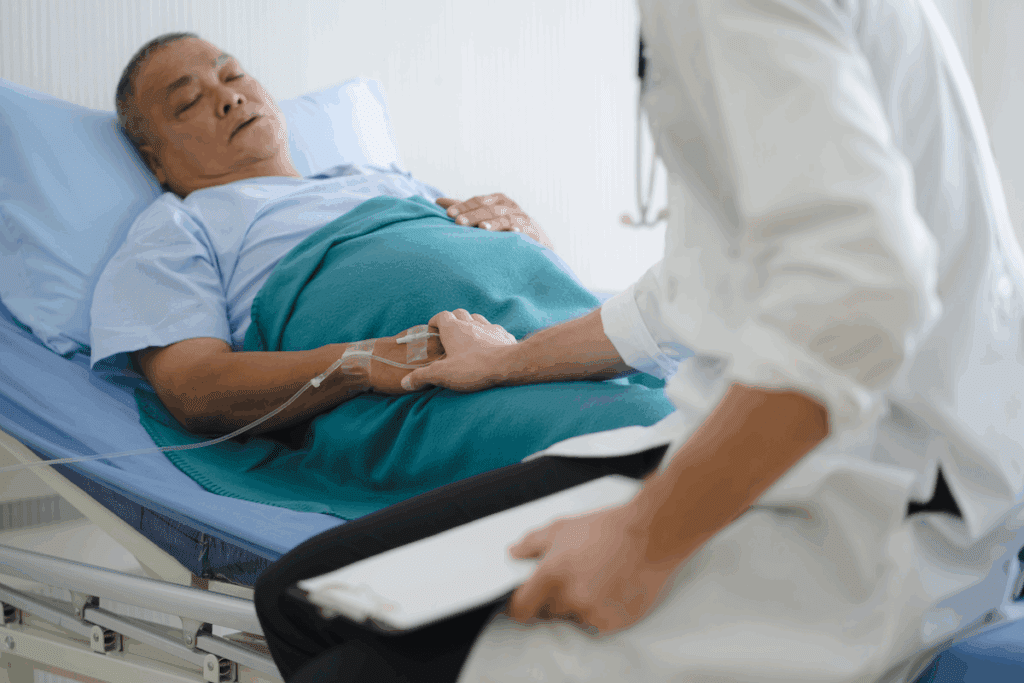Last Updated on November 26, 2025 by Bilal Hasdemir

A dead bowel, or gangrenous bowel, is a serious condition. It happens when a part of the intestine loses blood, causing tissue death. Conditions like ischemic colitis and mesenteric ischemia can cut off blood to the intestines. This can lead to gangrene if not treated. Discover 5 key warning signs of a dead bowel, its causes, and how to recognize a gangrenous colon.
It’s vital to get a quick diagnosis and treatment for this condition. Knowing the signs of bowel infarction can save lives. At Liv Hospital, we focus on our patients. We act fast and follow the best standards for urgent cases.

A dead bowel, or bowel infarction, is a serious condition. It happens when the intestines don’t get enough blood. This can be due to many reasons, like blocked arteries or veins, or something physically blocking the way.
Bowel infarction happens when the intestines don’t get enough blood. This leads to ischemia and then necrosis of the tissue. The exact cause depends on how severe and long-lasting the lack of blood is, and the body’s overall health.
The problem starts with a blockage or a drop in blood flow. This can be from a blocked artery, a blood clot in a vein, or something physically blocking the intestines. As the lack of blood gets worse, it causes tissue death. This can lead to a hole in the intestine and infection if not treated quickly.
The small bowel and colon react differently to a lack of blood. Small bowel infarction is more common because it needs more blood and has less backup.
Colonic infarction is rarer but just as dangerous, mainly in people with vascular diseases or other conditions that affect blood flow to the colon. Knowing these differences helps doctors diagnose and treat bowel infarction better.

It’s important to know what causes dead bowel and intestinal gangrene. These issues often happen when blood flow to the intestines is cut off. Many things can lead to this problem.
Arterial occlusion is a big reason for dead bowel. It happens when an embolism or thrombosis blocks blood flow. Atrial fibrillation and atherosclerosis can cause these blockages. Without blood, the bowel can become ischemic, and gangrene can set in.
Venous thrombosis, or blood clots in veins, also cuts off blood flow to the intestines. This is often linked to hypercoagulability, where blood clots more easily. Cancer and genetic predispositions can raise the risk of these clots.
Mechanical obstruction happens when something blocks the intestine. This can be due to adhesions from surgeries, hernias, or tumors. A volvulus, where part of the intestine twists, can also block blood flow and cause gangrene.
“Prompt recognition of these causes is essential for timely intervention,” say medical experts. Early treatment can greatly improve outcomes for those at risk of dead bowel and intestinal gangrene.
It’s important to know who is most at risk for bowel infarction. This helps in catching it early and stopping it. Some people are more likely to get it because of their age, health history, and other conditions.
Older adults face a higher risk of bowel infarction. Age-related factors play a big role, as blood flow to the intestines can be affected. Also, conditions like diabetes and high blood pressure can damage blood vessels and reduce blood flow.
Having comorbidities makes it harder to diagnose and treat bowel infarction. Diabetes, for example, not only raises the risk but also slows down healing and affects the outcome.
People who have had previous abdominal surgeries are more likely to get bowel infarction. This is because adhesions can form and block the intestines, leading to infarction.
Adhesions from surgery can wrap around or twist the intestine, cutting off blood flow. This risk is higher if the surgery involves the intestines or other organs in the abdomen.
Cardiovascular conditions also increase the risk of bowel infarction. Heart problems like atrial fibrillation, heart failure, and atherosclerosis can cause blood clots or reduce blood flow to the intestines.
Hypercoagulability, or a tendency to form blood clots, is another risk factor. It can be caused by genetics, cancer, or certain medicines. This condition raises the risk of blood clots, which can lead to bowel infarction if not treated quickly.
Knowing who is at high risk helps doctors take steps to prevent bowel infarction. They can closely watch these individuals and possibly lower the number of cases and improve outcomes.
Sudden and severe abdominal pain can signal bowel infarction, a serious condition needing quick medical help. It’s important to know the signs of a dead bowel to get timely treatment.
The pain from gangrenous bowel is very intense. It might also cause vomiting and swelling in the abdomen. This pain starts suddenly and is very severe, unlike other abdominal pains that grow over time.
Key characteristics of the pain include:
The pain of gangrenous bowel is much more intense and starts quickly. Unlike other conditions, the pain from bowel infarction is severe right away.
Distinguishing features include:
Blood in stool, visible or hidden, and changes in bowel movements can mean bowel gangrene. This happens when the bowel doesn’t get enough blood, causing tissue death. It can lead to serious problems.
In bowel gangrene, stool looks different. Hematochezia, or fresh blood in the stool, is a big sign. It happens because of ulcers or dead tissue in the bowel. Melena, or black, tarry stools, means digested blood, pointing to bleeding higher up in the gut.
The look of the stool can tell us a lot. Bright red blood usually means a problem lower down, while melena points to bleeding higher up.
Hematochezia and melena are serious signs that need a quick doctor. Hematochezia can be due to many things, like diverticulitis or bowel gangrene. Melena often means bleeding in the upper gut, like from ulcers.
| Symptom | Description | Possible Cause |
| Hematochezia | Passage of fresh blood through the anus | Lower GI bleeding, bowel gangrene |
| Melena | Passage of black, tarry stools | Upper GI bleeding, ulcers |
| Altered Bowel Movements | Changes in frequency or consistency of stool | Bowel obstruction, ischemia |
Knowing about these symptoms helps doctors find and treat bowel gangrene fast. If you see these signs, get medical help right away to avoid worse problems.
Bowel infarction can lead to serious issues like systemic infection and sepsis. This happens when the affected bowel tissue gets infected. It’s a life-threatening situation. It’s important to spot these signs early.
The body reacts to infection with fever and chills. These are signs of the body’s fight against the infection. In bowel infarction, these symptoms show the infection is spreading.
Fever often comes with a fast heart rate and breathing. Chills suggest a severe infection. If not treated, it could lead to sepsis.
Sepsis can cause big changes in the heart and blood flow. This includes low blood pressure and poor blood flow to important organs. It can lead to septic shock, a serious condition that needs quick action.
The heart and blood changes come from the infection, the body’s immune response, and certain chemicals. Watching for these signs is key to knowing if the patient’s condition is getting worse.
Sepsis can also affect the mind. Patients might seem confused, disoriented, or have changes in their level of consciousness. These changes can start small but get worse fast if not treated.
If someone with suspected bowel infarction shows mental changes, it’s important to check for sepsis right away. Quick action is needed to avoid serious brain damage or death.
Abdominal distension and tenderness are key signs of bowel infarction that need quick medical help. These symptoms happen when gas and fluid build up in the intestines. This causes swelling and pain.
Healthcare providers look for several signs during a physical exam. These signs point to a dead bowel:
Table: Physical Examination Findings in Dead Bowel
| Sign | Description |
| Abdominal Tenderness | Pain upon palpation of the abdomen |
| Guarding | Muscle tension in response to palpation |
| Rebound Tenderness | Pain upon release of pressure during palpation |
Symptoms of abdominal distension and tenderness can get worse fast if not treated. As the condition gets worse, the pain can spread and get more intense. It may cover a bigger area of the abdomen.
Other symptoms like nausea, vomiting, and fever might also appear. These changes happen quickly, showing why fast medical check-ups are so important.
Spotting abdominal distension and tenderness early can really help patients. Quick action can stop things from getting worse and save lives.
Severe nausea, vomiting, and dehydration are serious signs of bowel infarction. This condition is very dangerous and can harm your health a lot. It’s important to get help right away if you notice these symptoms.
Bowel infarction can cause many symptoms in the stomach and intestines. Severe nausea and vomiting are common. They happen because the body tries to deal with the lack of blood flow.
Severe vomiting and dehydration can cause big problems with fluids and electrolytes. These issues can mess with how your body works. They can even lead to more serious problems.
In conclusion, severe nausea, vomiting, and dehydration are big warning signs of bowel infarction. You need to see a doctor right away. Quick action can stop things from getting worse and help you feel better.
When gangrenous intestine is suspected, a detailed diagnostic plan is needed. This plan includes clinical checks, imaging, lab tests, and sometimes surgery or endoscopy.
Imaging is key in diagnosing gangrenous intestine. CT angiography helps spot blockages and check if the bowel is alive. It shows the blood vessels in detail, helping doctors see how bad the ischemia is.
Doppler ultrasound is also important. It looks at blood flow in the intestines’ vessels. It can find blockages in the arteries that feed the intestines.
| Imaging Modality | Advantages | Limitations |
| CT Angiography | High sensitivity for vascular occlusions, detailed vascular imaging | Contrast exposure, radiation |
| Doppler Ultrasound | Non-invasive, assesses blood flow, no radiation | Operator-dependent, limited depth penetration |
Labs are vital in diagnosing gangrenous intestine. Ischemia biomarkers, like lactlevelsvels show tissue lack of oxygen. High white blood cell counts and inflammatory markers also hint at ischemia.
A full lab test might include:
Endoscopic procedures can look directly at the intestine’s lining. Though risky, they can show mucosal ischemia.
Surgical exploration is often the best way to diagnose. It lets doctors see the bowel directly and check if it’s alive. It’s key when other tests are unclear.
Quick diagnosis and treatment are vital. They help avoid serious problems and improve survival chances for those with suspected gangrenous intestine.
Effective treatment of dead bowel starts with quick surgery. “The sooner the intervention, the better the chances of recovery,” say doctors. Managing dead bowel means using a full plan to fix the problem.
Often, emergency surgery is needed to take out the dead bowel part. This is called bowel resection. It’s key to stop more problems. Surgical intervention removes dead tissue and helps the bowel work properly again.
Doctors decide on surgery based on how bad the condition is and the patient’s health. Sometimes, minimally invasive surgical techniques are used. This can make recovery faster and reduce scars.
Along with surgery, antibiotic therapy is key in treating dead bowel. Antibiotics fight infection and stop it from spreading. Fluids and nutrition are also important in managing the condition.
“Antibiotic therapy is essential in the treatment of dead bowel to prevent sepsis and promote recovery.”
After surgery, care is vital for recovery. This includes watching for any problems and giving nutritional support to help the patient get strong. Nutrition might be through IV or a special diet, depending on the patient.
A team effort is needed to manage the dead bowel well. This includes surgery, antibiotics, and care after surgery. With these steps, doctors can greatly improve patient results.
Dead bowel, or gangrenous bowel, is a serious condition that needs quick action. The high death rate shows how vital early treatment is to save lives.
Research shows that quick surgery and aggressive care can lower death rates. Spotting signs like severe pain, blood in stool, and infection early is key to starting the right treatment.
Managing dead bowel well means working together. This includes emergency surgery, antibiotics, and care to support the patient. Knowing the causes and signs helps doctors act fast to help patients.
To lower death rates from bowel disease, we must work together. We need to spread the word, diagnose early, and treat quickly. This way, we can help more people survive this severe condition.
A dead bowel, also known as gangrenous bowel or bowel necrosis, happens when the blood supply stops. This leads to tissue death. Symptoms include severe abdominal pain and blood in the stool.Other signs are abdominal distension, nausea, vomiting, and signs of infection.
Bowel infarction is caused by reduced blood flow to the bowel. This can happen due to arterial occlusion, venous thrombosis, or mechanical obstruction. These conditions can cause ischemia and gangrene.
Older adults and those with previous abdominal surgeries are at higher risk. Also, people with cardiovascular conditions are at risk. Other factors include hypercoagulability and previous bowel obstruction.
Warning signs include severe and sudden abdominal pain. Also, blood in stool and altered bowel movements are signs. Signs of systemic infection and sepsis are also important. Abdominal distension and tenderness, and severe nausea, vomiting, and dehydration are other signs.
Diagnosis involves imaging studies like CT angiography and Doppler ultrasound. Laboratory tests detect biomarkers of ischemia. Endoscopic or surgical procedures are used to directly visualize the bowel.
Treatment involves emergency surgery to remove dead bowel tissue. Antibiotic therapy is used to manage infection. Post-surgical care supports recovery and manages complications.
While some risk factors cannot be changed, managing conditions like cardiovascular disease is important. Being aware of warning signs can help in early detection and treatment.
The prognosis depends on the promptness and effectiveness of treatment. Early intervention can significantly improve survival rates. Delayed treatment is associated with higher mortality.
Complications include sepsis, organ failure, and death if not promptly treated. Survivors may experience long-term gastrointestinal issues. They may require ongoing medical care.
Intestinal gangrene is characterized by tissue death due to a lack of blood supply. It differs from other bowel conditions that may not involve necrosis.
Subscribe to our e-newsletter to stay informed about the latest innovations in the world of health and exclusive offers!